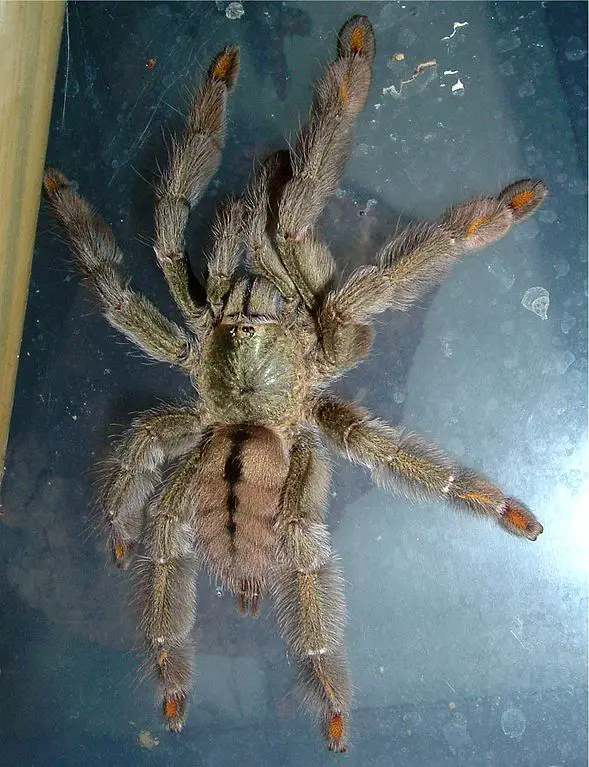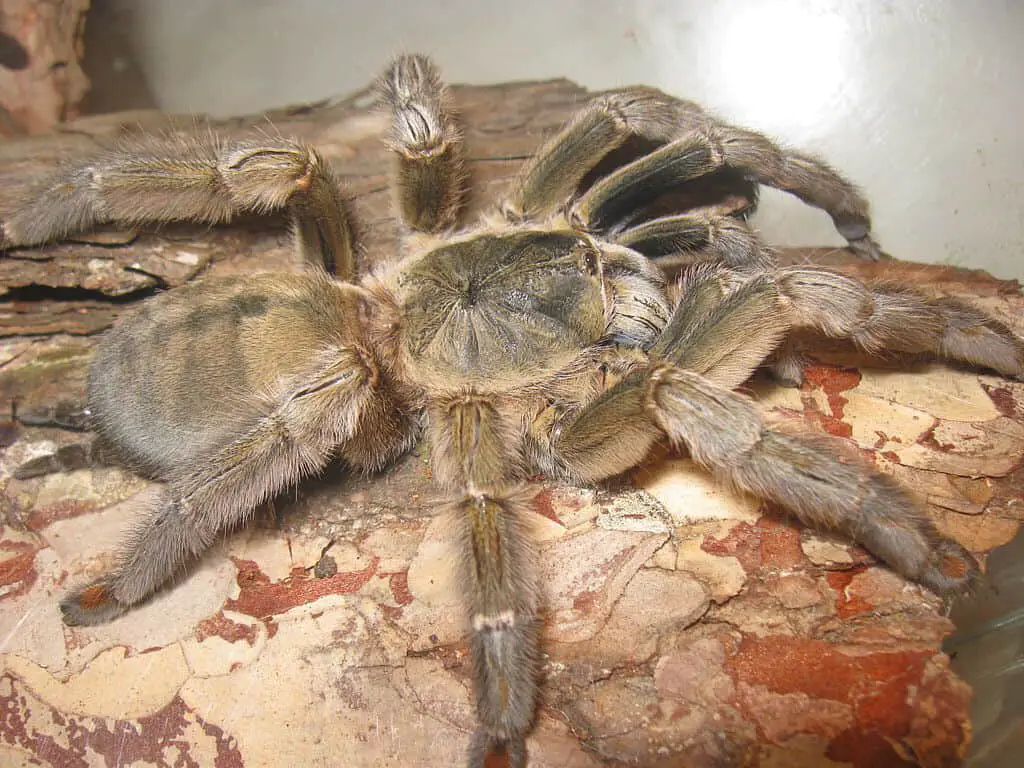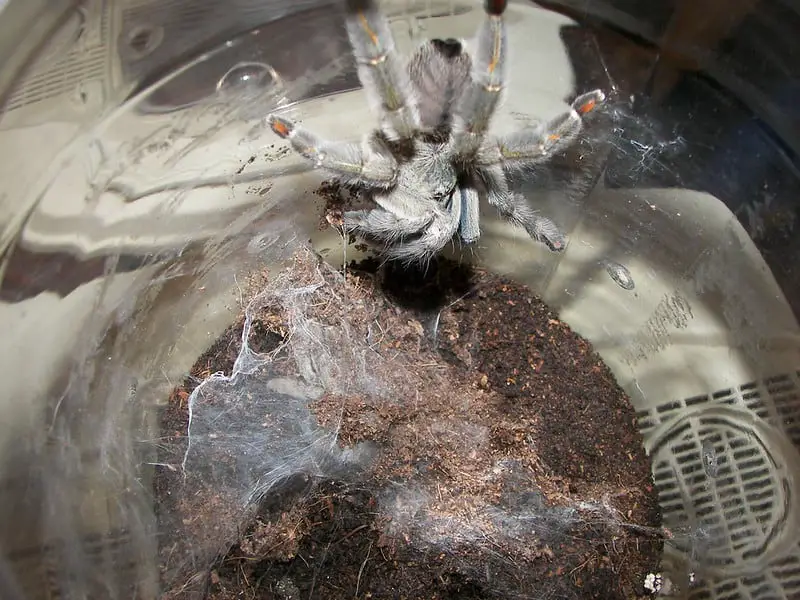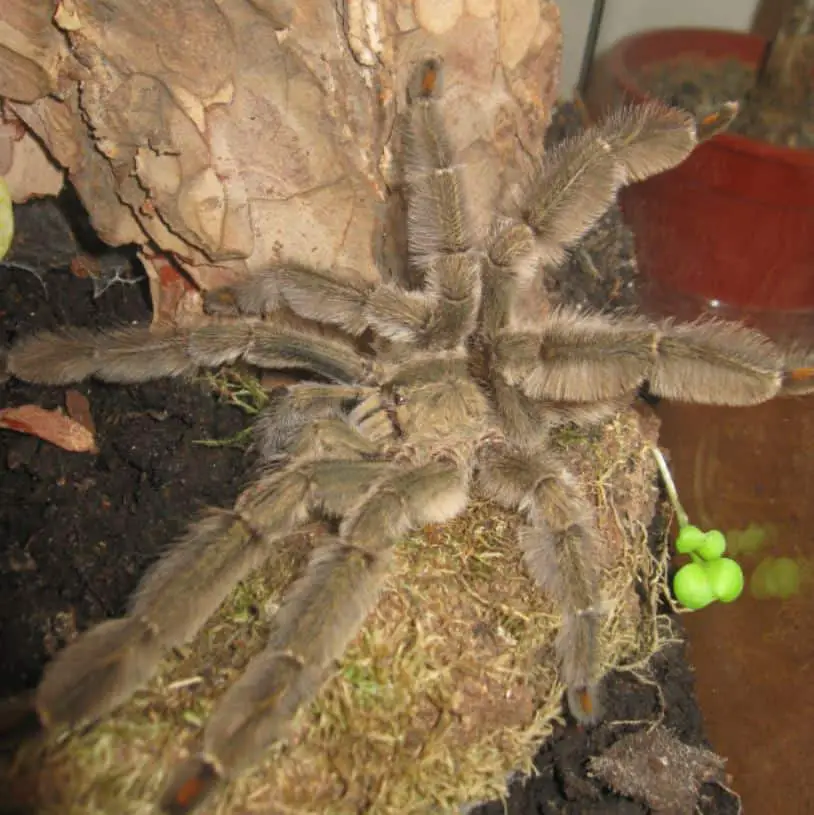The Trinidad Chevron Tarantula (Psalmopoeus cambridgei) is an arboreal New World tarantula species native to the island nation of Trinidad.
It’s an old species that’s been cared for by hobbyists for decades. They’re not the most brightly colored species but they’re coveted among collectors for their unique chevron-shaped markings.
They’re quite an aggressive species so caution should be exercised when interacting with them.
If this species has caught your attention and you’d like to add it to your collection you’ve come to the right place because today we’ll go over everything you need to know about the Trinidad Chevron Tarantula!

Trinidad Chevron Tarantula Care Sheet
| Species Name | Psalmopoeus cambridgei |
| Family Name | Theraphosidae |
| Common Names | Trinidad Chevron Tarantula |
| Category | New World |
| Type | Arboreal |
| Native Location | Trinidad |
| Leg Span | Up to 7 inches (~18 cm) |
| Growth Speed | Very fast |
| Urticating Hairs | No |
| Social | Solitary |
| Diet | Crickets, roaches, mealworms |
| Temperature | 75 to 80 degrees Fahrenheit |
| Humidity | 70 to 80% |
| Lifespan | Female: 10 to 12 years / Male: 2 to 3 years |
| Experience required | Intermediate |
| Minimum tank size | A vertical enclosure that’s at least 3 times as long as their leg span |
Trinidad Chevron Tarantula Overview
The Psalmopoeus cambridgei, more commonly known as the Trinidad Chevron Tarantula, is a species that’s endemic to the island of Trinidad.
They’re an arboreal tarantula so they spend the majority of their lives in the trees where they create silken tube webs and hunt bats, frogs, lizards, mice, and insects.
Appearance & Varieties

The Trinidad Chevron Tarantula gets its name from the dark chevron-shaped markings it has on its abdomen.
This species is sexually dimorphic, which means that males look different than females. Not only is the male quite a bit smaller than the female, but they also have different colors.
A fully grown male typically has a leg span of about 5 inches while fully grown females are about 6 inches in size. In addition, females usually have a larger abdomen and carapace in relation to their size.
Color-wise, males are uniform grey or brown in color while females have shades of green and brown with characteristic red or orange markings on the legs.
Slings, juveniles, and subadults also look quite different from their fully-grown counterparts. They’re typically darker in color until they’re fully grown.
Price
The Trinidad Chevron Tarantula is definitely not an expensive species. Slings can be found for sale for around $25 to $40.
Adults are usually a bit more expensive, but still quite affordable at about $80 for a female.
Temperament & Behavior
The Trinidad Chevron Tarantula is not a very docile spider. They’re quite defensive and fast, so be careful when interacting with them.
As is standard with tarantulas, they prefer to run from threats but if they cannot then they’re quite quick to strike a threat posture to deter any threats from coming closer. If whoever is threatening them does not back off, they will bite. They do have venom, but it’s luckily quite weak.
One interesting aspect of this spider is that even though they’re a New World species, they do not have any urticating hairs.
They’re not a shy species and will typically spend quite a bit of time out in the open. This combined with their decent size makes them excellent as show spiders.
They’re also quite an active spider that will move more than some other species. However, as is the case with most tarantula species, they’re nocturnal which means that they will be most active during the evening and the night.
Handling
The nature of this spider does not make them very suitable for handling. If you like to handle your tarantulas it’s best to do so with a species that’s more docile such as the Antilles Pinktoe or the Arizona Blonde.
The Trinidad Chevron Tarantula is quite easy to startle which makes it easy for accidents to happen.
If you do decide to handle them make sure that you have experience handling tarantulas and that you are very careful to avoid dropping them.
Caring for a Trinidad Chevron Tarantula

It’s not very difficult to make a Trinidad Chevron happy. All they really need to thrive is a proper enclosure with the right temperature and humidity levels, food, good substrate, and water.
Here’s exactly what you need to provide for them to give them everything they need.
Tank setup
As an arboreal species, it’s important that you give them an enclosure that has more vertical than horizontal space.
Slings can be kept in a vial with a twig in it, but make sure that you move them into larger enclosures as they get bigger.
For adults, make sure that their enclosure is at least 3 times as tall as their leg span. That means that if you have a 6″ female Chevron their enclosure should be at least 18 inches tall. I also recommend choosing an enclosure with front-opening doors rather than doors that open at the top.
To give them a home and hiding spot in their enclosure, place a hollow piece of cork bark or branch that’s about 10″ long vertically in their terrarium so that they can climb it. This will serve as a great hide/retreat for them and will make them feel right at home.
You can also place other artificial plants and rocks in the enclosure to make the enclosure more visually appealing.
Substrate
Adult Chevron Tarantulas need about 2 inches of substrate in their terrarium. They do not burrow so more is not necessary. Good material to use as substrate is peat moss, coconut fiber, vermiculite, or a mixture of these.
Temperature & humidity
When keeping tarantulas it’s best to closely simulate their home climate because that’s what they’re used to in the wild.
For the Trinidad Chevron, their natural temperature is typically between 70 and 90 degrees Fahrenheit but they’re most comfortable at temperatures around 75 to 80 degrees.
Their natural habitat is very humid, especially during the rainy season, so try to simulate this in captivity. Try to reach a humidity in their enclosure that’s between 70 and 80%.
Humidity levels are not set in stone and they can also do quite well in lower humidity.
Ventilation is also quite important so make sure that you have some holes in the enclosure to allow for air circulation.
Social
The Trinidad Chevron Tarantula is not a social species so they should not be kept in an enclosure with others. They are solitary and communal housing can result in cannibalism.
Molting
The Trinidad Chevron Tarantula is a very fast-growing spider. Males can reach their full size in one year!
As a result of this, they will molt quite frequently. Before they’re about to molt you’ll notice that they won’t be very willing to eat. Don’t worry, this is completely normal. They do this because it makes it easier for them to shed their old exoskeleton.
During the molting process try to disturb them as little as possible. Molting is a stressful time for our eight-legged friends and if we disturb them we just make it worse and can even make the molt fail!
After they’ve successfully molted they should not be fed for a couple of days. This is to give their fangs enough time to harden.
Diet & Feeding

To support their fast growth the Trinidad Chevron Tarantula has quite a large appetite.
Slings should be fed flightless fruit flies or cricket legs. You can feed the slings as much as you want because there really is no risk of overeating.
Once they get a bit bigger and enter the juvenile stage of their life they can start to eat live prey. You can start by giving them baby crickets and work your way up to larger ones over time.
Adults can be fed roaches or adult crickets. Feed them one roach or 5 large crickets a week. They can also eat the occasional small lizard or rodent, but this is definitely not necessary and many owners choose to only feed them crickets, which is perfectly fine.
The amount of food that a tarantula needs is not set in stone, just like for humans. Females typically eat more than males and larger specimens have a bigger appetite than smaller ones.
A good way to check if you’re feeding them enough is to keep an eye on their abdomen. If they’re eating too much the abdomen will get big, if they’re not getting enough food it will shrink.
Like all animals, the Trinidad Chevron Tarantula will also need water.
Slings will drink droplets that you can put in their enclosure by dripping water down the sides of the enclosure or by misting the side of the enclosure.
Adults can drink from a water bowl. To make it easier for the spider to drink you can superglue their bowl to their tree.
Health & Lifespan
The Trinidad Chevron Tarantula has a decent lifespan of about 10 to 12 years for females and 2 to 3 years for males. It’s quite easy to keep them healthy to ensure that they live as long as possible.
The only things to look out for are spider mites, mold growth, and parasites. You can avoid these problems by not feeding them wild-caught insects, keeping their enclosure clean, removing uneaten food, and refreshing their water frequently.
Trinidad Chevron Tarantula Quick Facts
- The Psalmopoeus cambridgei was named after arachnologist Frederick Octavius Pickard-Cambridge
- Females can produce 200 to 300 eggs in two separate egg sacs after every mating, which hatch after about 6 weeks
- They’re heavy webbers that create impressive web structures.
- Their venom is not very potent but is used in certain therapeutics
Final words: Is the Trinidad Chevron the right Tarantula for you?
The Trinidad Chevron is not the best beginner species because of how fast and defensive they are. They’re also not very good for people who want to handle their spiders.
However, as display spiders for intermediate and advanced owners, they’re an excellent choice. They’re fairly active and they have a unique appearance that’s sure to steal the show.
They’re also quite cheap and readily available!
- How Long Do American Eskimo Dogs Live? Important Factors and Care Tips - September 29, 2023
- Do American Bulldogs Need Grooming? Essential Tips and Care Guidelines - September 29, 2023
- Do Bengal Cats Enjoy Playing? Essential Tips for Keeping Them Active - September 29, 2023